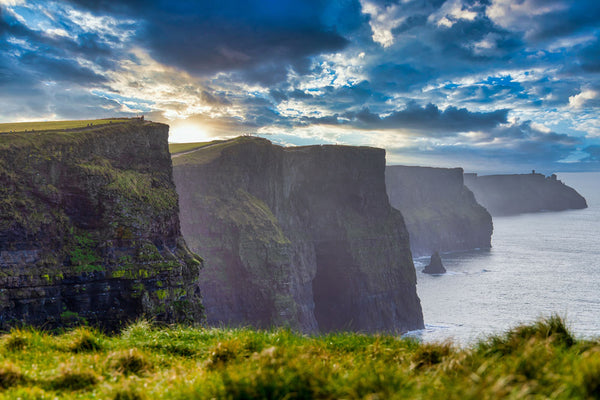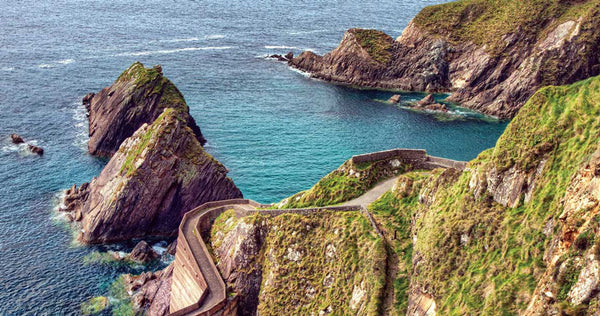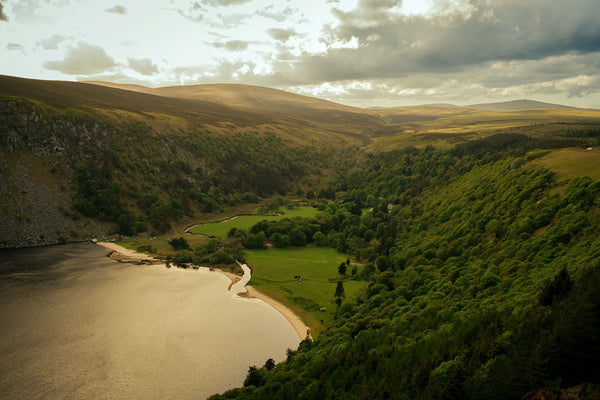Backpacking Routes Across Ireland (Guide for 2021)
Jan 07, 2021
If you’re looking for the next place for your backpacking adventure, Ireland might be the way to go. There are many options for you to choose from and we're bringing you the best ones.
Ireland is an unavoidable destination for travelers backpacking through Europe. Whether you’re coming solo or with a group, prepare for an unforgettable experience, filled with amazing cities, stunning nature, and welcoming hosts. Read our Ireland backpacking guide to get the most out of backpacking through this beautiful European country.
Why Ireland is Great for Backpacking
There’s a reason Ireland is called the Emerald Isle — it is one of the most beautiful European places to visit when it comes to nature.
There’s lots of history and cultural landmarks to see on your backpacking routes, but natural landmarks are just as breathtaking. The Cliffs of Moher, Giants Causeway, and the Ring of Kerry are the most famous ones, and there are loads of others scattered around the country.

Beautiful scenery in Ireland - picture by Bhargava Marripati, pexels.com
Backpacking Ireland: How to Prepare
Backpacking in Ireland can be challenging even for the most experienced hikers. To make sure that everything on your trip goes smoothly, take a look at how to prepare for backpacking and camping in Ireland.
Travel Visa
Ireland is part of the European Union, so if you’re coming from one of the 27 member countries, you can visit Ireland without a visa. If not, you’ll have to apply for a short-stay visa, which allows you to be in the country for 90 days.
Currency
The official currency in Ireland is the euro (1 euro = 1.2 US dollars).
What to Pack
No matter where you’re going, it’s always smart to plan what to pack. But if there’s a time when having the essentials is essential, it’s when you’re on a backpacking trip. Imagine being in the middle of nowhere, your phone battery dies, and you forgot to bring a travel charger! Of course, you want to avoid this from happening, so please check out our travel gear list for Europe and the list of backpacking essentials. Some things you’ll definitely need are:
Best Time to Travel to Ireland
March to May and September to November: If you want to truly enjoy and have a piece of Irish nature all to yourself, visit it during late spring or early fall. This way you’ll get to avoid two things: summer crowds and cold winter weather.
The only inconvenience about backpacking through Ireland in spring and fall is the fact that it could get quite rainy — but this shouldn’t be a problem if you prepare correctly.
Summer: Some would say that the best time to go backpacking through Ireland is during the warm summer months. While June, July, and August are the sunniest, this is also a period with the most crowds and the highest prices.
How to Get Around
If you’re planning to visit more than a couple of places, it’s best to rent a car.
- Pluses of renting a car: Ireland has an excellent motorway system, so you can easily find your way around. Also, the roads are not filled with traffic. One more bonus is that you’ll get great views along the way.
- Avoid buses and trains: The country’s public transport isn’t the greatest — buses can take a long time to get you to your destination and the train network isn’t the best.
How to Save Money
If you want to go backpacking through Ireland on a budget, you’ll want to think of ways of saving money before you embark on your adventure. Keep these things in mind:
- Cook for yourself: This way you’ll avoid paying for overpriced meals in restaurants and spend money on groceries instead (which are not expensive). Luckily, many Airbnbs and hostels in Ireland have kitchens at your disposal.
- Book in advance: If there are some tourist attractions you don’t want to miss, you could save quite a bit of money if you get your tickets a couple of months earlier (you’ll also save time and not wait in long queues).
- Pack everything you need: This way you won’t have to buy any last-minute gadgets, which could get quite expensive if you’re shopping near tourist attractions.
Best Accommodation Options in Ireland
As backpacking across Ireland is a popular choice for many travelers, there is no shortage of accommodation options. If you're visiting popular cities like Cork, Galway, or Dublin, you don't have to worry about finding accommodation last-minute. But if you're heading somewhere remote, book in advance to make sure you have a place to stay.
Hostels
A vast majority of backpackers choose to stay in hostels — no wonder, as there are many positives that come with this kind of accommodation. Hostels are cheap, they're common across the country (so you can be sure that you'll find a hostel near your destination), and they're a great spot for meeting other travelers.
- Average hostel room price: €10 to €20 ($12 to $23) a night.
Hotels
If you want a private bathroom, you'll have to book a hotel. Of course, this type of luxury comes with a price.
- Average budget hotel room price: €50 ($56) a night for a private room with a bathroom.
- Bigger cities: be prepared to pay even €10 ($12) a night more.
Airbnbs
While backpacking in Ireland, you'll be spending a whole lot of time outdoors, oftentimes surrounded by other people. So we understand if you're looking for accommodation options that offer more privacy. If that's the case, Airbnb is definitely the best way to go.
- Average price for a full apartment with a kitchen: €54 ($60) a night.
- Average price for a shared room: €18 ($20) a night.
Best Backpacking Routes in Ireland
The European Emerald offers dozens of backpacking routes. The routes vary according to:
- Length: you can choose one-day or multi-day routes.
- Level of needed hiking skills: there are easy, medium, and difficult routes.
Take a look at some of the best backpacking trails in Ireland and pick the one that suits you the most.

Dingle way Ireland, picture by Lukasz Pajor - Fotolia
Dingle Way: Tralee to Camp
- Distance: 18 km (11 miles)
- Estimated time: 6h
- Level: Easy
- Starts/ends: The Kerry County Museum in Tralee
The beautiful Dingle Way walk will take you near the Blennerville Windmill, the largest working windmill in the British Isles, built in the 1800s. Follow the Dingle Way directions to complete the route successfully. On your hike, you’ll get to see a couple of rivers, ascend for 200 meters (656 feet), and return to the starting point.
Ballycotton Cliff Walk
- Distance: 8 km (11 miles)
- Estimated time: 4h
- Level: Easy
- Starts: The village of Ballycotton
- Ends: Ballyandreen beach
The Ballycotton Cliff Walk is one of the easiest Ireland backpacking routes. This doesn't mean that you won't get to enjoy amazing scenery — the gentle cliff track offers views of meadows on one side and the wild Atlantic on the other. To take in all that nature, there are plenty of seated viewpoints along the way.
Wicklow Way: Marlay Park to Knockree
- Distance: 20.1 km (4.9 miles)
- Estimated time: 6h 45m
- Level: Moderate
- Starts: Marlay Park
- Ends: Knockerry Hills
The route starts at the car park near the Marlay House, where you can find a cozy coffee shop and craft workshops. The trail goes through the park, then ascends onto Dublin Hills and forest vistas. You'll pass Kilmashogue, Fairy Castle, the Glencullen River, descend to the Enniskerry Road, and end at the Knockerry Hill.

The Wicklow Mountains National Park, picture by Joe King
Lough Bray Loop
- Distance: 6.6 km (4 miles)
- Estimated time: 2h 20m
- Level: Moderate
- Starts/ends: Lough Bray
This route is located on one of the most beautiful mountain saddles in Ireland, the Sally Gap. Due to the boggy terrain, steep sections, and lack of an adequately marked trail, it's considered to be moderate to hard. You'll circle two lakes (Lough Bray Lower and Lough Bray Upper) and witness unforgettable views of the surrounding area, which is a part of the Wicklow Mountains National Park, one of six Irish national parks.
Spinc and the Wicklow Way (Red route)
- Distance: 11 km (6.8 miles)
- Estimated time: 4h
- Level: Difficult
- Starts/ends: Upper Lake Car Park Glendalough
The trail follows the main Spinc trail, up onto the boardwalk, for about 1.7 km (1 mile), then turns to Lugduff Mountain. Once you reach this spot, you can take a breather and maybe see deer or birds such as ravens and merlins. The trail connects with the Wicklow Way track that will eventually lead you back to the start.
Carrauntoohil via Coomloughra Horseshoe
- Distance: 12.9 km (8 miles)
- Estimated time: 5h 30m
- Level: Difficult
- Starts/ends: The Hydro Road
The Coomloughra Horseshoe Loop Walk in County Kerry is often described as Ireland's best ridge walk. You'll hike over several mountain peaks in the MacGillycuddy's Reeks, including the four highest mountains in Ireland. If the weather will be on your side, prepare for spectacular scenery. Keep in mind that, even in the best weather conditions, this route requires mountain experience. Be careful to start the hike early enough to complete it during daylight hours.
The Sligo Way
- Distance: 78.9 km (49 miles)
- Estimated time: Multi-day
- Level: Moderate
- Starts: Lough Talt
- Ends: The town of Dromahair
The Sligo Way route starts at the County of Sligo in the northwest of the country and ends in the town of Dromahair in the County Leitrim. The route begins in the mountains, so the total ascent of the entire route is only 900 meters (2950 feet), and there are no significant climbs. Attractions include an early lake dwelling on Lough Talt and megalithic tombs in west Sligo.

Wicklow Ireland, picture by Tom Balabaud, pexels.com
Wicklow Way (Complete)
- Distance: 128 km (79.5 miles)
- Estimated time: Multi-day
- Level: Difficult
- Starts: Marlay Park
- Ends: The village of Clonegal
Wicklow Way is the oldest such route in Ireland, opened in 1981. It starts in Marlay Park in the south suburbs of Dublin, then ascends to Kilmashogue Mountain, where you can enjoy the panoramic views of Ireland's capital. You'll pass Kelly's Glen, the Glencullen Valley, and Prince William's Seat, then enter the County Wicklow through Curtlestown Wood. The route is challenging, but with many amazing views along the way.
Sheep's Head Trail Main Loop
- Distance: 91.9 km (57 miles)
- Estimated time: Multi-day
- Level: Difficult
- Starts/ends: Bantry West Trailhead
This popular long-distance loop route encompasses the Sheep's Head Peninsula and the Bantry area. To finish it successfully, just follow the Sheep's Head Way yellow walking man markers. If you're a skilled backpacker, it will take you about 5 to 6 days to complete it. You'll start at the Bantry, pass the Bantry Bay, Dunmanus Bay, and the Sheep’s Head Lighthouse, before returning back to the starting point.
The Kerry Way
- Distance: 215 km (133.5 miles)
- Estimated time: Multi-day
- Level: Difficult
- Starts/ends: Killarney
If you came to the country for the views, you need to put the Kerry Way on your backpacking Ireland itinerary. The route takes in the entire length of the Iveragh Peninsula in southwestern Ireland, and the average hiker will need 7 to 10 days to complete it. You can camp along the way, or choose to stay at some of the many B&Bs and pubs.
Your feet are itchy and you want to plan more than one trip? The Elture team gets you! Read our other guides and get inspired for other backpacking destinations.

